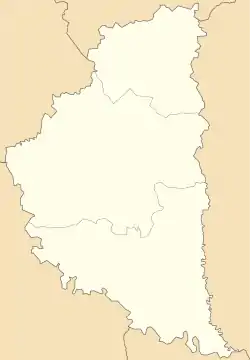Vyshnivets
Vyshnivets (Ukrainian: Вишнівець, translit. Vyshnivets’; Polish: Wiśniowiec) is an urban-type settlement in the Zbarazh Raion (district) of the Ternopil Oblast (province) of western Ukraine. Population: 3,236 (2020 est.)[1]
Vyshnivets
Вишнівець | |
|---|---|
 Coat of arms | |
 Vyshnivets Location of Vyshnivets  Vyshnivets Vyshnivets (Ukraine) | |
| Coordinates: 49°54′00″N 25°44′00″E | |
| Country | |
| Oblast | |
| Raion | Zbarazh Raion |
| First mentioned | 1395 |
| Town status | 1960 |
| Area | |
| • Total | 6 km2 (2 sq mi) |
| Population (2020) | |
| • Total | 3,236 |
| • Density | 540/km2 (1,400/sq mi) |
| Time zone | UTC+2 (EET) |
| • Summer (DST) | UTC+3 (EEST) |
| Postal code | 47313 |
| Area code(s) | +380 |
| Website | gska2 |
Vyshnivets is better known as a family estate of the Polish royal house of Wiśniowiecki (originally Ruthenian princes), which is known for switching from Eastern Orthodoxy to Catholicism (as part of Polonization) as well as the Cossack Hetman Dmytro "Baida" Vyshnevetsky, who established the first Zaporizhian Sich on the island of Small (Mala) Khortytsia on the Dnipro River in 1552 in defense of the lands.
History
Early History, to 1939
The area was first mentioned in 1395 soon after annexation of the Kingdom of Galicia-Volhynia by the Kingdom of Poland when the first defensive castle was constructed in the area by Dmytro Korybut who had acquired the land from Great Prince Vitautas[2]
The town is located on the Horyn River, a right tributary of the Prypiat. Before World War II the village was located in Poland.
The town served as a family seat of the Polish princely Wiśniowiecki family, as of the 15th century, and received its name from the family. The town was noted for its extensive cherry orchards.[3] In the mid-1500s, one of the family's descendants, Dmytro Vyshnevetsky (1516-1563), was distinguished by his service to Ivan the Terrible. His grandson, Jeremi Wiśniowiecki, also known as Yarema Vyshnevetsky (1612-1651) was also a distinguished military commander. During the time of the leadership of Princes Michael and Valusah Wiśniowiecki, as of 1674, the town was on the verge of becoming a Russian capital.[3]
Architectural landmarks in the town include a 15th-century castle; and palace and park, constructed in the 18th century by the Vyshnevetskyi family.
1939-1945
The town is historically associated with the Holocaust. Prior to the commencement of World War II, approximately 5,000 persons of Jewish faith were residents of the town.[3] The town was directly in the path of the German invasion of Russia in June 1941, following the repudiation by Germany of the Ribbentrop-Molotov Pact.[3]
On August 11–12, 1942, German troops and Ukrainian Auxiliary Police executed nearly 2,700 Jewish men, women and children. Of those executed, approximately 900 were children.[4] It is estimated that less than 100 of the town residents of Jewish faith ultimately survived the Holocaust.[3]
Post-1945
In 1960, Vyshnivets was changed from the status of a village, to that of an Urban-type settlement. The population of the town was 3,469 as of 1994.
 The Wiśniowiecki family palace.
The Wiśniowiecki family palace. Rear view of the Wiśniowiecki family palace.
Rear view of the Wiśniowiecki family palace. The Voskresenska Church of the town.
The Voskresenska Church of the town.
References
- "Чисельність наявного населення України (Actual population of Ukraine)" (PDF) (in Ukrainian). State Statistics Service of Ukraine. Retrieved 30 September 2020.
- Uncredited, Vyshnivets; baltia.com. Retrieved 2016-09-09.
- Louis Parnes, The Vanishing Generations (1954), as extracted by Arlene Parnes,Vishnevets. JewishGen, KehilaLinks. Retrieved 2016-09-05.
- Martin Dean, German Ghettoization in Occupied Ukraine: Regional Patterns and Sources. Paper presented at The Holocaust in Ukraine: New Sources and Perspectives. Centre for Advanced Holocaust Studies, United States Holocaust Memorial Museum, 2013. Retrieved 2016-09-05.
External links
- ShtetLinks - Vishnevets at JewishGen
- "Urban-type settlement of Vyshnivets". Verkhovna Rada (in Ukrainian). Retrieved March 30, 2007.
- "Vyshnivets". Castles.com (in Ukrainian). Retrieved March 30, 2007.
- "Vyshnivets: Truth and myths of the kniaz Vyshnevetsky family". Den (Day) (in Ukrainian). September 30, 2005. Retrieved March 30, 2007.
- "Vyshnivets". Ternopilska Torhovo-Promyslova Palata (in Ukrainian). Archived from the original on March 10, 2007. Retrieved March 30, 2007.
- Klymenko, Serhiy. "Photo excursion around Vyshnovets". klymenko.data-tec.net (in Ukrainian). Retrieved March 30, 2007.
- Vlasenko, Petro. "Vyshnivets, Ternopilska Oblast". ua.vlasenko.net (in Russian). Retrieved March 30, 2007.